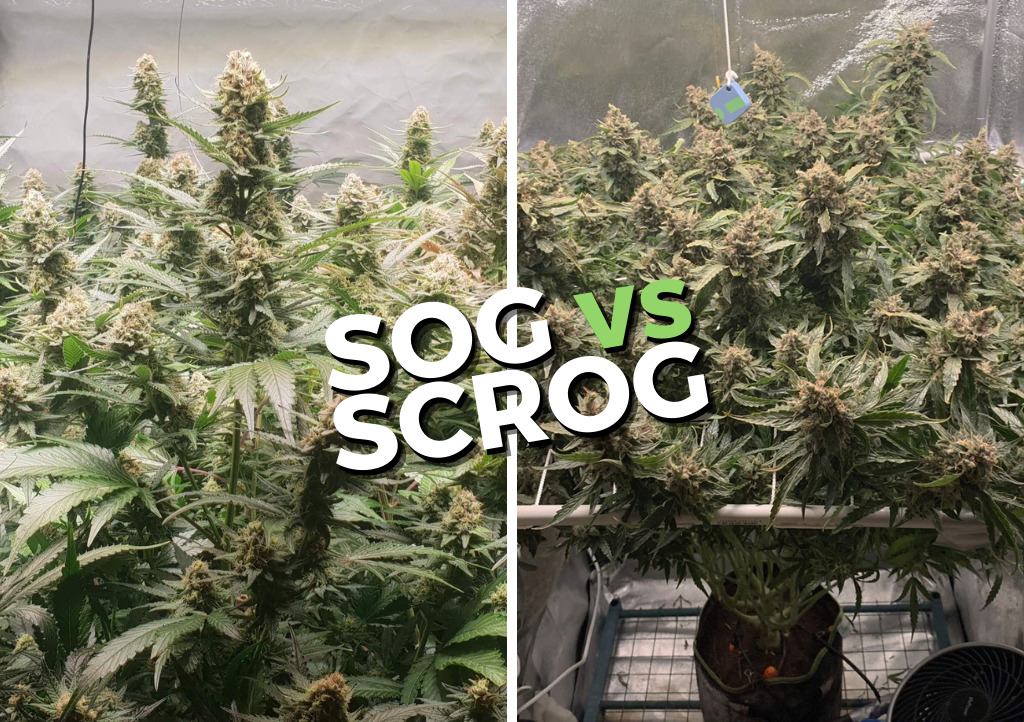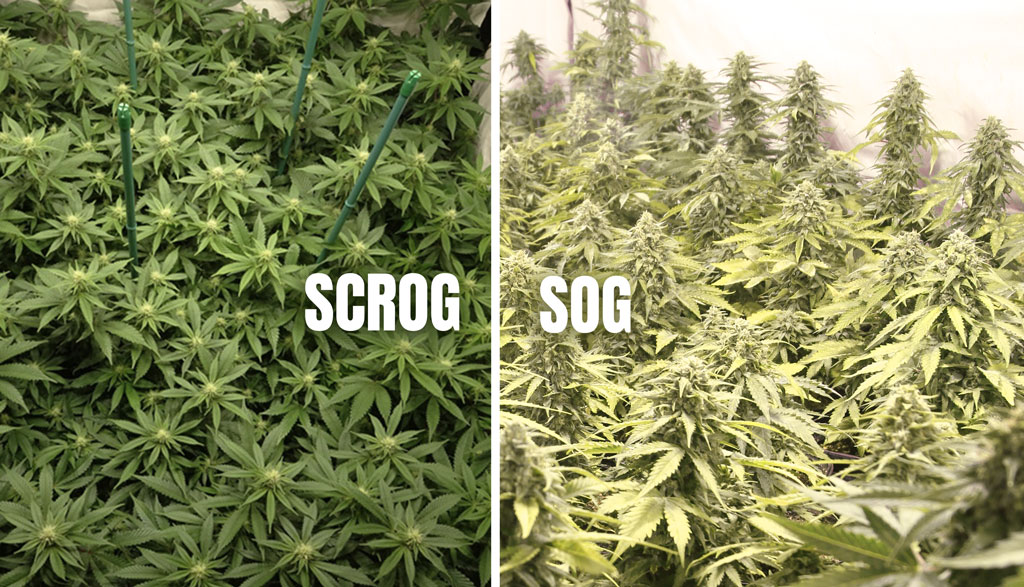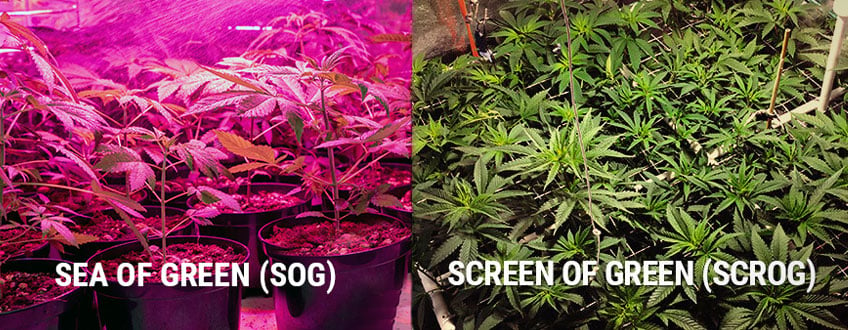Les techniques SOG (Sea of Green) et ScrOG (Screen of Green) sont deux méthodes populaires utilisées dans la culture du cannabis en raison des rendements accrus qu'elles peuvent offrir. Le SOG consiste à planter un grand nombre de plants avec un temps de végétation minimal, optimisant ainsi l'énorme augmentation des rendements provenant d'une culture densément tassée. Alternativement, le ScrOG offre également un moyen de produire des rendements plus élevés en utilisant un faible nombre de plantes avec une croissance végétative prolongée.
De plus, cette technique oblige les producteurs à utiliser un écran qui aide à créer une canopée uniforme qui maximise l'exposition à la lumière et favorise le développement ultérieur des têtes. Avec cette méthode, il est possible d'utiliser des mesures d'entraînement à faible stress "Low Stress Training" (LST), telles que l'attache des branches au grillage avec des attaches douces ou un cordon de jardinage, leur permettant de s'asseoir à plat dessus et de maximiser la production de fleurs.
Les Essentiels du Sea of Green (SOG) et Screen of Green (ScrOG)
Les techniques de culture du cannabis Sea of Green (SOG) et Screen of Green (ScrOG) sont conçues pour augmenter les rendements des cultures. Aucune des deux méthodes n’est nécessairement meilleure que l’autre, et chacune possède son propre ensemble d’avantages qui plaisent à des styles de culture spécifiques.
Les producteurs de marijuana qui n’ont adopté aucune de ces techniques risquent de découvrir qu’ils passent à côté d’un potentiel de rendement supplémentaire disponible en utilisant les méthodes SOG ou ScrOG. De nombreux producteurs connaissent un tel succès après avoir opté pour l’une de ces techniques de culture qu’ils ne recommenceront plus jamais à cultiver des plantes naturellement.
Dans l’ensemble, ni le SOG ni le ScrOG ne nécessitent une courbe d’apprentissage particulièrement difficile pour réussir ; les cultivateurs expérimentés ne devraient avoir aucune difficulté à maîtriser les deux. Les deux méthodes utilisent les mêmes principes de base, bien qu’il existe de légères différences entre elles ; en fin de compte, c'est à chaque producteur de décider quelle méthode sera la plus bénéfique pour son exploitation particulière.
Avantages et Inconvénients du Sea of Green (SOG)
La technique de culture Sea Of Green (SOG) est un moyen populaire et efficace de produire des rendements élevés dans un espace limité. Grâce à l’utilisation de nombreuses plantes de cannabis de plus petite taille, un grand nombre de plantes peuvent être cultivées dans de petits conteneurs et avec peu ou pas de période de croissance végétative, ce qui donne lieu à une mer de fleurs vertes. Même si les rendements par plante peuvent être inférieurs aux attentes, pour ceux qui disposent d'un espace limité, cette approche entraîne souvent de meilleures récoltes.
En revanche, la technique SOG présente certains inconvénients pour les producteurs qui recherchent la qualité plutôt que la quantité. En raison du laps de temps limité entre la plantation et la floraison, les branches latérales n’ont aucune chance de former des fleurs importantes et une grande partie de la production de têtes se produira plutôt sur la tige centrale principale.
De plus, comme chaque plante produit moins de têtes que si elle était cultivée directement sur le sol ou dans un milieu hydroponique, la qualité globale est généralement compromise par le nombre, ce qui oblige à faire très attention lors de la récolte des récoltes individuellement.
Avantages et Inconvénients du Screen of Green (ScrOG)
L’un des principaux avantages de l’utilisation de la méthode Screen of Green (ScrOG) pour cultiver du cannabis est qu’elle permet une plus grande exposition à la lumière que les autres méthodes. En effet, les branches des plantes sont tressées à travers les trous d’un écran qui garantit que chaque fleur soit autant exposée à la lumière que possible.
Cette technique nécessite généralement également des pots plus grands, ce qui signifie que les plantes peuvent rester plus longtemps dans des conditions végétatives. Cela permet également de cultiver un plus petit nombre de plantes par mètre carré, tout en obtenant un rendement par plante plus élevé.
Cependant, le ScrOG a aussi ses inconvénients. Les producteurs expérimentés préfèrent les écrans métalliques avec des trous plus petits espacés de 2 à 5 cm aux filets ou cordons tendus, car la plus petite variation des ouvertures garantit qu'il n'y a pas de distorsion ou d'étirement du maillage pendant la croissance.
De plus, l'installation et la maintenance peuvent demander beaucoup de travail, car tous les quelques jours, vous devez ajuster, déplacer et former vos succursales pour assurer une couverture maximale de votre écran. Dans l’ensemble cependant, s’il est effectué correctement et avec un entretien régulier, le ScrOG peut être un moyen facile d’obtenir des rendements plus élevés avec une ou plusieurs plantes dans un espace limité.
Cultiver : Avantages et Inconvénients du ScrOG
La méthode ScrOG (Screen of Green) est une technique de culture qui existe depuis un certain temps et qui est populaire auprès des cultivateurs de cannabis en intérieur. Généralement, cette méthode consiste à utiliser des écrans grillagés ou des filets en tissu pour créer un « écran vert » qui vous permet de contrôler la taille et la forme de vos plantes, ce qui les aide à rester dans le point idéal de distribution de la lumière.
Cela permet de maximiser l’espace et le nombre de plantes utilisés pour remplir une zone donnée. Certains avantages de l'utilisation de cette technique incluent des cycles de culture plus rapides en raison d'un cycle végétatif moins long et de rendements plus élevés avec un nombre réduit de plantes. Vous avez également plus de contrôle sur la hauteur des plantes, ce qui facilite le maintien de toutes les fleurs et permet d'économiser de l'argent sur les graines de cannabis ou les clones.
SOG vs ScrOG : Phase de Végétation
Le stade de croissance de la végétation est une différence clé entre SOG et ScrOG. Pour le SOG, les producteurs cultivent généralement leurs plantes dans de petits conteneurs de 4 à 6 litres, dans des conditions de lumière de 12/12 dès le début ou pendant quelques semaines avant de passer à la floraison. Ils trouvent également plus abordable de prélever des boutures sur une plante mère plutôt que d’acheter des graines individuelles pour chaque plante.
D’un autre côté, lors de la culture en ScrOG, le cannabis nécessite une période prolongée au stade végétatif. Cela signifie que les lumières sont réglées pour fournir 18 heures de lumière et 6 heures d'obscurité chaque jour afin que les plantes aient suffisamment d'énergie pour atteindre des niveaux de croissance élevés avant la floraison.
Pendant cette période, le cultivateur passera du temps à former la plante horizontalement afin que toutes les parties reçoivent des quantités égales de lumière et de nutriments. Lorsqu'il est réalisé correctement, le ScrOG peut conduire à des récoltes très productives avec des rendements plus élevés que ceux obtenus habituellement par le SOG.
SOG vs ScrOG : Phase de Floraison
SOG (Sea of Green) et ScrOG (Screen of Green) sont deux méthodes de culture populaires utilisées pour cultiver la marijuana. D’une part, SOG se concentre sur la maximisation du rendement par surface carrée en cultivant un grand nombre de petites plantes densément regroupées. Dans cette situation, la croissance latérale et les ramifications latérales sont souvent minimes en raison de l’espace exigu et de l’accès limité à la lumière.
En conséquence, une grande partie de la production de têtes provient des fleurs principales en raison du peu de ramifications latérales. Les producteurs utilisent généralement de petits conteneurs entre 4 et 11 litres comme conteneurs de plantation et ne s'attendent pas à des plantes volumineuses ; ils recevront plutôt un rendement plus élevé et davantage de têtes de qualité supérieure. Les graines à autofloraison peuvent être cultivées dans des conditions SOG car elles sont adaptées à des rendements maximaux plutôt qu'à une structure végétale spécifique comme ScrOG et LST.
D'un autre côté, le ScrOG s'appuie fortement sur la croissance latérale puisque les producteurs essaient de produire plusieurs sommets égaux en palissant ou en palissant les branches basses afin que la lumière atteigne uniformément toutes les parties de leurs plantes. La culture ScrOG implique un cycle de culture plus long, nécessitant souvent plusieurs mois de croissance végétative avant que la phase de floraison puisse commencer.
Cependant, une fois la phase de floraison commencée, les cultivateurs ScrOG peuvent récolter des rendements importants sur chaque plante, les cultivateurs expérimentés récoltant plusieurs centaines de grammes par plante. En comparaison, les producteurs SOG ne peuvent récolter qu'environ 30 grammes par plante, en fonction des conditions environnementales.
SOG vs ScrOG : Rendements et Potentiel
Lorsqu’il s’agit de cultiver du cannabis, il existe de nombreuses techniques de dressage parmi lesquelles choisir pour essayer d’optimiser vos rendements et votre puissance. Deux des plus populaires sont le SOG (Sea Of Green) et le ScrOG (Screen Of Green). Même si aucun des deux n’affectera directement la puissance de votre récolte finale, ils peuvent néanmoins l’avoir indirectement en fonction de la configuration.
Le SOG est une technique qui se concentre sur une culture rapide plutôt que sur de grandes têtes, idéalement en utilisant des plantes qui finissent leur floraison plus rapidement que 60 jours. En conséquence, vous vous retrouvez avec des têtes plus petites de différentes tailles, par opposition aux plus grosses têtes de ScrOG.
D'un autre côté, le ScrOG est conçu pour produire des rendements plus importants en remplissant plusieurs espaces uniformément dans une configuration en écran, permettant à chaque plante un meilleur accès à la lumière et aux nutriments tout en manipulant leur croissance de cannabis, permettant ainsi aux plantes plus grandes de créer des têtes supérieures et de lourdes ramifications latérales. La technique qui donne les meilleurs résultats sur la période dépend en grande partie de la taille de votre espace de culture.
Quelle que soit l’option, cependant, il est important d’utiliser des lampes de culture LED de qualité, de maintenir un contrôle strict des niveaux de nutrition et de maintenir des conditions environnementales stables – cela garantira des résultats optimaux, quelle que soit la technique que vous choisissez.
À Lire Plus: Programmes d’éclairage pour le cannabis à autofloraison.
Quand cultiver du cannabis avec SOG ou ScrOG?
Lorsqu'il s'agit de maximiser votre rendement en cannabis, deux des techniques les plus populaires parmi les cultivateurs chevronnés sont le SOG (Sea of Green) et le ScrOG (Screen of Green). Ces stratégies éprouvées nécessitent des investissements minimes, mais offrent un potentiel important lorsqu'il s'agit d'améliorer le volume et la qualité des récoltes. Lorsque vous décidez entre les deux, il est important de prendre en compte votre espace de culture spécifique en termes de superficie et de hauteur.
Le SOG est idéal pour les cultures à petite échelle, où le rendement maximum est ciblé dans des espaces plus courts, comme une armoire à plante unique ou une tente avec un espace vertical limité. Avec SOG, vous pourrez accueillir plusieurs plantes les unes à côté des autres en les palissant horizontalement lorsqu’elles atteignent leur stade de floraison.
D'un autre côté, si vous disposez d'un espace plus horizontal avec des plafonds bas ou si vous travaillez avec des variétés plus hautes qui ont besoin de soutien pendant leur croissance, le ScrOG pourrait être mieux adapté pour atteindre des rendements plus élevés avec une excellente répartition des sites de têtes. Bien que cela demande plus de travail, car les branches individuelles doivent être soigneusement formées sur un cadre en treillis pour une meilleure couverture, les résultats peuvent être vraiment spectaculaires lorsqu'ils sont effectués correctement.
À Lire Plus: Différence entre les plants de cannabis mâles et femelles
Risques pour les producteurs : SOG vs ScrOG
En matière de culture, le SOG et le ScrOG sont deux des techniques les plus utilisées. Chaque méthode a ses avantages et ses inconvénients, et les producteurs doivent peser les risques associés à chacune avant de décider laquelle leur convient le mieux.
L’un des plus grands risques potentiels de la culture SOG est le grand nombre de plantes qui doivent être cultivées pour en faire une technique réussie. Remplir une tente de 1,2 m par 1,2 m avec 15 à 20 plantes peut être une tâche ardue, et si vous n'avez l'habitude de cultiver qu'une ou deux plantes dans votre espace, alors le SOG n'est peut-être pas pour vous.
En comparaison, la culture ScrOG présente des avantages uniques que de nombreux cultivateurs amateurs préfèrent au SOG. Non seulement cela réduit le temps passé à s'occuper des plantes, mais cela permet également aux producteurs commerciaux de s'en tirer avec moins de plantes grâce à une efficacité accrue lors de leur formation sur le treillis de leur choix.
SOG Vs ScrOG : Conclusion
Les deux méthodes de jardinage populaires, SOG et ScrOG, présentent toutes deux des avantages et des inconvénients lorsqu'elles sont utilisées en combinaison avec l'espace de culture disponible et la variété de cannabis. En pratique, les producteurs doivent s'assurer que la technique utilisée est adaptée à leurs circonstances particulières afin de maximiser les performances de rendement.
Lors de la mise en place d'un filet pour la croissance du ScrOG, il est important de veiller à couvrir entièrement la zone de culture et à ne laisser aucun espace pour maximiser son efficacité. Cependant, si la hauteur est limitée ou si les plantes doivent rester discrètes des étrangers, cette technique ScrOG peut être préférable.
Alternativement, le SOG permettra d'augmenter la vitesse en l'absence de restrictions de hauteur de plafond, car il ne nécessite qu'un bref stade végétatif avant de transformer les plantes en stade de floraison ; cependant, plus de plantes sont nécessaires que si vous utilisez le ScrOG, ce qui peut rendre la culture du cannabis en intérieur délicate.
Dans l'ensemble, les deux techniques offrent des moyens efficaces de maximiser les rendements et la qualité en fonction de variables telles que la hauteur du plafond, le nombre de plantes et le degré de discrétion souhaité ; le producteur doit donc être conscient du choix approprié en fonction de sa situation et de ses préférences. En fin de compte, en comprenant ces facteurs, les producteurs peuvent mettre en œuvre avec succès la méthode la mieux adaptée à leur jardin.


 English
English 

